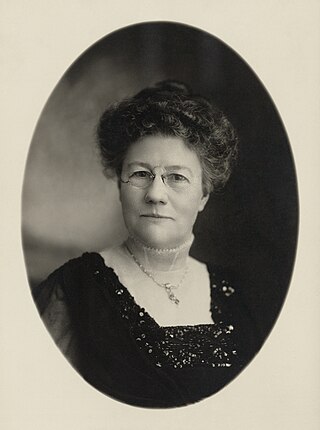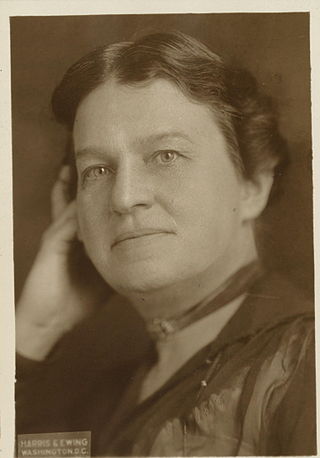
Crawfordsville is a city in Montgomery County in west central Indiana, United States, 49 miles (79 km) west by northwest of Indianapolis. As of the 2020 census, the city had a population of 16,306. The city is the county seat of Montgomery County, the only chartered city and the largest populated place in the county. It is the principal city of the Crawfordsville, IN Micropolitan Statistical Area, which encompasses all of Montgomery County. The city is also part of the Indianapolis–Carmel–Muncie, IN Combined Statistical Area.

Ida Husted Harper was an American author, journalist, columnist, and suffragist, as well as the author of a three-volume biography of suffrage leader Susan B. Anthony at Anthony's request. Harper also co-edited and collaborated with Anthony on volume four (1902) of the six-volume History of Woman Suffrage and completed the project by solo writing volumes five and six (1922) after Anthony's death. In addition, Harper served as secretary of the Indiana chapter of the National Woman Suffrage Association, became a prominent figure in the women's suffrage movement in the U.S., and wrote columns on women's issues for numerous newspapers across the United States. Harper traveled extensively, delivered lectures in support of women's rights, handled press relations for a women's suffrage amendment in California, headed the National American Woman Suffrage Association's national press bureau in New York City and the editorial correspondence department of the Leslie Bureau of Suffrage Education in Washington, D.C., and chaired the press committee of the International Council of Women.
Marion Harvie Barnard (1872–1969) was a suffragist. She was a member of the Woman's Franchise League of Indiana and the treasurer of the Indiana Equal Suffrage Association.

Mary Garrett Hay was an American suffragist and community organizer. She served as president of the Women's City Club of New York, the Woman Suffrage Party and the New York Equal Suffrage League. Hay was known for creating woman's suffrage groups across the country. She was also close to the notable suffragist, Carrie Chapman Catt, with one contemporary, Rachel Foster Avery, stating that Hay "really loves" Catt.

Florence Alice Riddick Boys was an American writer, clubwoman, suffragist, and state probation officer in Indiana.

Ella Riegel was an American suffragist and women's rights activist. Riegel was a graduate of the first class of Bryn Mawr College and would remain associated with the college the rest of her life.

Women's suffrage in Nevada began in the late 1860s. Lecturer and suffragist, Laura de Force Gordon, started giving women's suffrage speeches in the state starting in 1867. In 1869, Assemblyman Curtis J. Hillyer introduced a women's suffrage resolution in the Nevada Legislature. He also spoke out on women's rights. Hillyer's resolution passed, but like all proposed amendments to the state constitution, must pass one more time and then go out to a voter referendum. In 1870, Nevada held its first women's suffrage convention in Battle Mountain Station. In the late 1880s, women gained the right to run for school offices and the next year several women are elected to office. A few suffrage associations were formed in the mid 1890s, with a state group operating a few women's suffrage conventions. However, after 1899, most suffrage work slowed down or stopped altogether. In 1911, the Nevada Equal Franchise Society (NEFS) was formed. Attorney Felice Cohn wrote a women's suffrage resolution that was accepted and passed the Nevada Legislature. The resolution passed again in 1913 and will go out to the voters on November 3, 1914. Suffragists in the state organized heavily for the 1914 vote. Anne Henrietta Martin brought in suffragists and trade unionists from other states to help campaign. Martin and Mabel Vernon traveled around the state in a rented Ford Model T, covering thousands of miles. Suffragists in Nevada visited mining towns and even went down into mines to talk to voters. On November 3, the voters of Nevada voted overwhelmingly for women's suffrage. Even though Nevada women won the vote, they did not stop campaigning for women's suffrage. Nevada suffragists aided other states' campaigns and worked towards securing a federal suffrage amendment. On February 7, 1920, Nevada became the 28th state to ratify the Nineteenth Amendment.

Women's suffrage in Pennsylvania was an outgrowth of the abolitionist movement in the state. Early women's suffrage advocates in Pennsylvania not only wanted equal suffrage for white women, but for all African Americans. The first women's rights convention in the state was organized by Quakers and held in Chester County in 1852. Philadelphia would host the fifth National Women's Rights Convention in 1854. Later years saw suffragists forming a statewide group, the Pennsylvania Woman Suffrage Association (PWSA), and other smaller groups throughout the state. Early efforts moved slowly, but steadily, with suffragists raising awareness and winning endorsements from labor unions.

Vida Newsom was an American suffragist and clubwoman, based in Columbus, Indiana. She was described in a 1925 headline as "One of State's Busiest Women."

Caroline Henderson Griffiths was an American diplomat's wife and philanthropist. After World War I, she organized book and equipment donations for children's libraries in Belgium and France.

Julia Blackburn Duke Henning was an American suffragist and clubwoman, based in Louisville, Kentucky.

Mary Dudley Hussey was an American lawyer, physician, and suffragist. Hussey worked towards women's rights both through legal efforts and through activism. She was based in New Jersey.

Julia Shipley Carroll, later Julia S. Pollister, was an American suffragist, clubwoman, magazine editor, and business manager. She was president of the Women's Advertising Club of St. Louis, Missouri.
Frances Ellen Burr was an American suffragist and writer from Connecticut.












